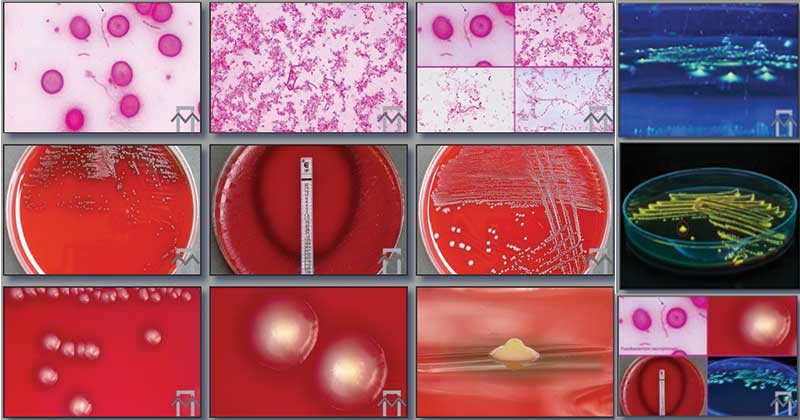
Image Source: Microbe-Canvas
Interesting Science Videos
Some of the characteristics are as follows:
| Basic Characteristics | Properties (Fusobacterium necrophorum) |
| Bile Growth | Variable |
| Capsule | Negative (-ve) |
| Catalase | Negative (-ve) |
| Flagella | Negative (-ve) |
| Gas | Positive (+ve) |
| Gelatin Hydrolysis | Variable |
| Gram Staining | Gram-negative bacteria |
| H2S | Positive (+ve) |
| Hemolysis | Positive (+ve) (alpha- and beta-hemolysis may be observed) |
| Indole | Positive (+ve) |
| Methylene Blue Reduction | Positive (+ve) |
| Motility | Negative (-ve) |
| MR (Methyl Red) | Negative (-ve) |
| Nitrate Reduction | Negative (-ve) |
| Oxidase | Negative (-ve) |
| Shape | Pleomorphic rod ranging from small, almost coccoid bodies to filaments, with parallel sides and blunt or tapering ends. |
| Spore | Negative (-ve) |
| VP (Voges Proskauer) | Negative (-ve) |
Fermentation of |
|
| Adonitol | Negative (-ve) |
| Arabinose | Negative (-ve) |
| Cellobiose | Negative (-ve) |
| DNase | Positive (+ve) |
| Dulcitol | Negative (-ve) |
| Fructose | Variable |
| Glucose | Variable |
| Glycerol | Negative (-ve) |
| Glycogen | Negative (-ve) |
| Inositol | Negative (-ve) |
| Inulin | Negative (-ve) |
| Lactose | Negative (-ve) |
| Maltose | Negative (-ve) |
| Mannitol | Negative (-ve) |
| Mannose | Negative (-ve) |
| Raffinose | Negative (-ve) |
| Rhamnose | Negative (-ve) |
| Ribose | Negative (-ve) |
| Sorbitol | Negative (-ve) |
| Sucrose | Negative (-ve) |
Enzymatic Reactions |
|
| N-Acetyl-glucosaminidase | Negative (-ve) |
| Acid Phosphatase | Positive (+ve) |
| Alkaline Phosphatase | Positive (+ve) |
| Beta-Lactamase | Positive (+ve) |
| Casein Hydrolysis | Positive (+ve) |
| Esculin Hydrolysis | Negative (-ve) |
| β -Glucosidase | Negative (-ve) |
| Lecithinase | Negative (-ve) |
| Lipase | Positive (+ve) |
| Lysine decarboxylase | Negative (-ve) |
| Phosphatase | Negative (-ve) |
| Tryptophanase | Positive (+ve) |
References
- Editors: Krieg, N.R., Ludwig, W., Whitman, W., Hedlund, B.P., Paster, B.J., Staley, J.T., Ward, N., Brown, D., Parte, A. (2010). Bergey’s Manual of Systematic Bacteriology. Volume 4: The Bacteroidetes, Spirochaetes, Tenericutes (Mollicutes), Acidobacteria, Fibrobacteres, Fusobacteria, Dictyoglomi, Gemmatimonadetes, Lentisphaerae, Verrucomicrobia, Chlamydiae, and Planctomycetes.
- https://cmr.asm.org/content/20/4/622
- https://www.ncbi.nlm.nih.gov/pmc/articles/PMC4184658/
- https://www.sciencedirect.com/topics/immunology-and-microbiology/fusobacterium-necrophorum
- https://www.vetbact.org/?artid=103
- https://catalog.hardydiagnostics.com/cp_prod/Content/hugo/Fusobacterium.htm
- https://mmbr.asm.org/content/41/2/373.full.pdf
- https://mmbr.asm.org/content/mmbr/41/2/373.full.pdf
- https://www.microbiologyresearch.org/docserver/fulltext/jmm/46/10/medmicro-46-10865.pdf?expires=1555583249&id=id&accname=guest&checksum=D0C39A2B120D8EF19150A1D56B77AFA7
- https://journals.sagepub.com/doi/pdf/10.1177/1040638713491407
